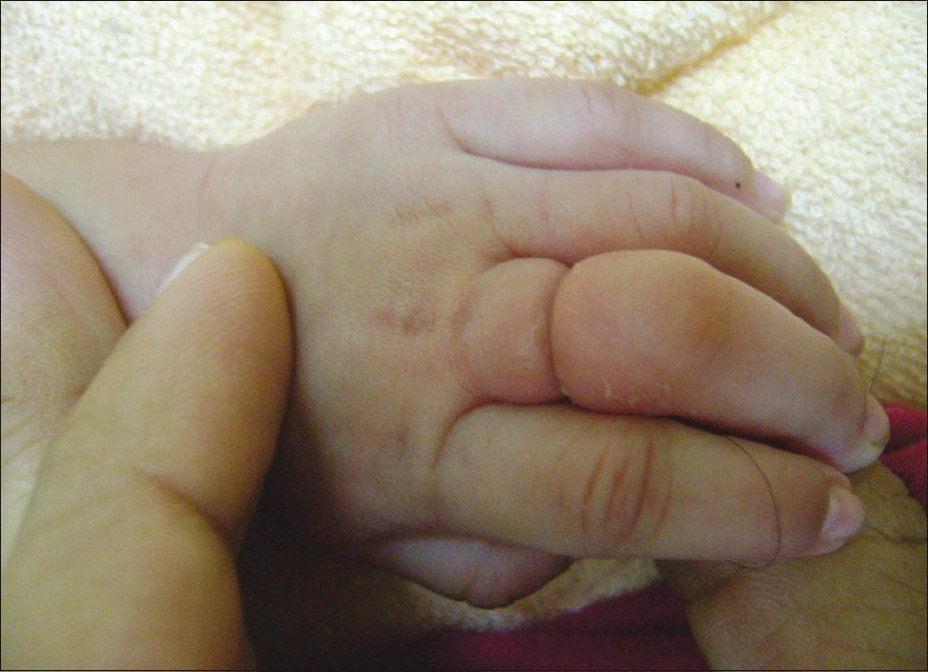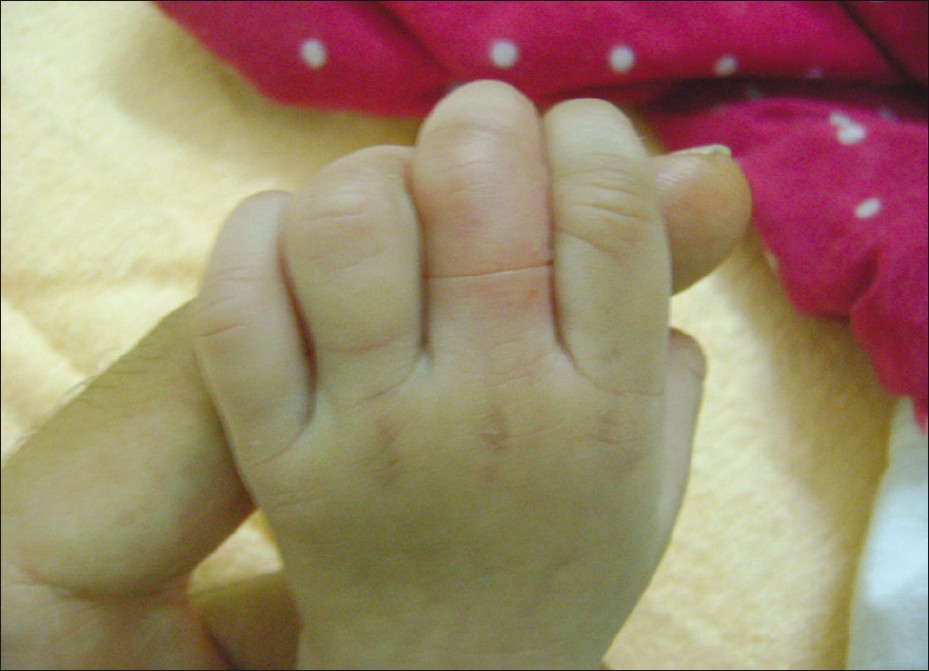Translate this page into:
Digital strangulation in a child: Tourniquet syndrome
2 Department of Paediatric Surgery, JLNH and RC, Bhilai, Chhattisgarh, India
3 Department of Surgery, Maharishi Markandeshwer Institute of Medical Sciences and Research, Ambala, Haryana, India
4 Department of Radiology and Imaging, Maharishi Markandeshwer Institute of Medical Sciences and Research, Ambala, Haryana, India
Correspondence Address:
Pradeep Sahu
c/o Dr. Rikki Singal, Dr. Kundan Lal Hospital, Ahmedgarh, Distt Sangrur, Punjab - 148 021
India
| How to cite this article: Shankar R, Rao P S, Shetty KB, Sahu P, Singal R, Gupta S. Digital strangulation in a child: Tourniquet syndrome. Indian J Dermatol Venereol Leprol 2012;78:408 |
Sir,
Hair tourniquet syndrome is an uncommon clinical phenomenon that involves hair or thread becoming tightly wound around a young child′s appendage, ie, fingers, toes, external genitals, etc, thus resulting in ischemic changes or loss of the appendage. [1] Here, we report a case to highlight the importance of prompt recognition with meticulous examination of any infant with features of cellulitis of the appendages followed by appropriate intervention, to consider the possibility of child abuse in a few selected cases and to counsel the postpartum mothers about this entity as a preventive measure. Awareness of the entity, prompt recognition, and intervention is the key to prevent further harm to child. Most cases tend to be accidental, especially those involving the fingers and toes. Involvement of the toe has been frequently reported, but that of fingers is under-reported.
A one-month old girl was brought to the casualty at late night with a complaint of being unable to sleep. The child had been irritable since the morning. Her mother had also noticed redness and swelling of the left middle finger since afternoon.
On examination, the infant was found to have erythema and edema of the entire left middle finger [Figure - 1]. A single strand of hair was found encircling the proximal phalanx and formed a knot on the volar aspect. This formed a circumferential groove over the finger which was reddish and swollen. An 11-number surgical blade was used to cut the strand of hair wound around the finger. After few minutes, the redness of the finger seemed to resolve and child became comfortable [Figure - 2]. In the follow-up period of 2 days, the edema and redness had subsided completely. The parents were advised to apply a depilatory cream on the child′s finger.
 |
| Figure 1: Swelling of left middle finger beyond the constriction |
 |
| Figure 2: Swelling reduced after removal of the hair strand |
Hair tourniquet or hair thread tourniquet syndrome is an uncommon entity most likely to involve the toes and fingers. In a review of 66 cases from the medical literature, 43% involved the toes, 33% involved the external genitalia, and 24% involved the fingers. [2] In the toes, the constriction is usually caused by the human hair, while in fingers, it is usually by the fibres of the clothing. The median age of the infants with finger involvement was 3 weeks and 4 months with the toe involvement. [2]
Human hair is extremely thin and hence easily overlooked, especially when a patient presents with a foreign body reaction and local swelling. Hairs are more supple and stretchable when moist but they shrink and tighten when dried. [3] The tissue injury from the constricting bands may be caused by ischemic compression of the blood vessels and the direct cutting action of the tourniquet. [4] The hair or fibre can get embedded in the tissue with overlying skin bridge and escape detection.
Treatment begins with recognition of the condition and appreciation of the gravity of the problem. All cases with features of cellulitis of an appendage should be thoroughly examined, if necessary, by using a loupe to look for any constricting material. The offending material should be removed completely, if necessary, under anesthesia to relieve the strangulation.
Most cases of fingers and toes tend to be accidental, but the constriction around the genitals is frequently intentional. [5] Postpartum mothers should be counselled with regard to the possibility of such a situation if they have excessive hair loss and that their infant should be carefully checked on a regular basis to ensure that there are no hairs entangled between their fingers and toes.
Hair tourniquet syndrome is a relatively rare and dangerous, but preventable, condition of infants. Such a child presenting with cellulitis of an appendage should be examined immediately to avoid a delay in recognition and intervention. Prompt recognition and treatment of the condition is vital to attain a good outcome and prevent further harm to the child. New parents should be cautioned about child negligence/abuse and appropriately advised regarding this unusual entity. If the disease is not recognized on time then it can lead to severe morbidity/mortality such as ischemia, necrosis, or amputation of the finger. With early awareness of the condition, unnecessary complications and surgery can be prevented. The patient also should be advised to apply depilatory ointment.
| 1. |
Peckler B, Hsu CK. Tourniquet syndrome: A review of constricting band removal. J Emerg Med 2001;20:253-62.
[Google Scholar]
|
| 2. |
Barton DJ, Sloan GM, Nichter LS, Reinisch JF. Hair-thread tourniquet syndrome. Pediatrics 1988;82:925-8.
[Google Scholar]
|
| 3. |
Bangroo AK, Smita C. Hair tourniquet syndrome. J Indian Assoc Pediatr Surg 2005;10:55-6.
[Google Scholar]
|
| 4. |
Bacon JL, Burgis JT. Hair thread tourniquet syndrome in adolescents: A presentation and review of the literature. J Pediatr Adolesc Gynecol 2005;18:155-6.
[Google Scholar]
|
| 5. |
Sudhan ST, Gupta S, Plutarco C. Toe tourniquet syndrome-accidental or intentional? Eur J Pediatr 2001;159:866-74.
[Google Scholar]
|
Fulltext Views
3,293
PDF downloads
3,874





